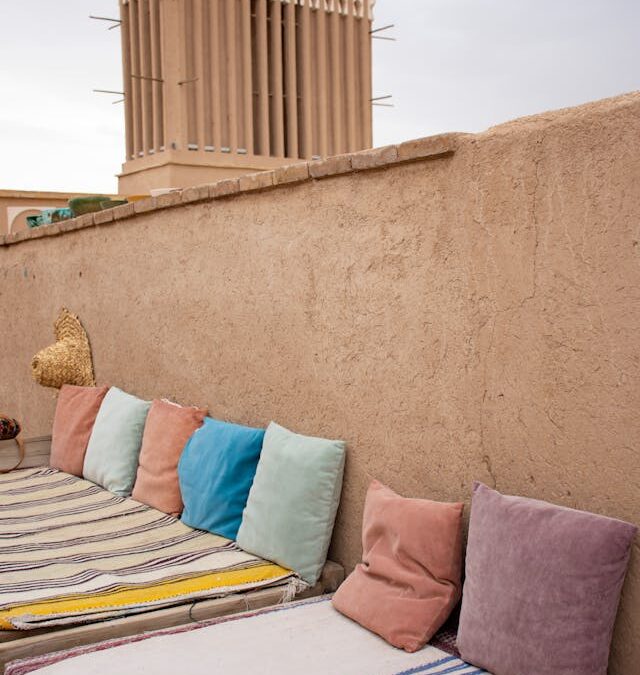With the increasing urgency to minimize carbon emissions, leaders across diverse industries are actively exploring environmentally friendly alternatives to address some of the largest sources of emissions.
Global temperatures have continued to soar, which has led to a higher demand for one of the largest producers of CO2: air conditioning. According to some climate experts, air conditioning accounts for approximately 1.95 billion tons of CO2 emissions yearly—nearly 4 percent of total global carbon emissions.
Fortunately, green alternatives allow us to cool our homes without air conditioning or even electricity. Ancient civilizations in Northern Africa, the Middle East, and India pioneered a natural cooling system called a windcatcher thousands of years ago. The application of this ancient technology in modern times holds the potential to alleviate the impact of climate change.
How Do Windcatchers Work?
Windcatchers are structures designed to harness natural wind flow to passively cool and ventilate buildings. They use the principles of fluid dynamics to channel and direct winds into buildings. This natural cooling system has been used for millennia in arid regions with hot climates.
The basic design of a windcatcher consists of a tall, open tower with multiple openings at different heights. Wind flows through the tower, creating a pressure difference, which induces air movement. The lower openings capture cool air, while the upper openings release hot air. This process creates a natural upward draft. Some windcatchers also feature a series of internal pathways to improve airflow and control the direction of the incoming cool air.
Windcatcher Cooling Methods
Windcatcher technology has developed significantly since its origins in the ancient world. Today, there are a variety of different cooling methods. The best method often depends on the location of the windcatcher, including the climate and the direction it faces.
Underground Cooling
Windcatchers can cool air by exposing it to cool underground thermal masses. Typically, beyond a depth of approximately 6 meters, the soil and groundwater maintain the annual mean-average temperature—a depth commonly utilized for geothermal heat pumps. The soil’s thermal inertia mitigates daily and annual temperature fluctuations.
In arid climates with extreme daily temperature swings, a thermal mass of thick masonry walls can be used to retain warmth at night and provide cooling during the day. Windcatchers leverage this principle by drawing air over materials cooled during the night or winter, effectively acting as heat reservoirs.
Ice houses are one example of a common use of subterranean windcatchers in arid climates. These structures are used to store frozen water overnight in desert areas where temperatures plummet after dark or over winter in more temperate climates. Ice houses sometimes use windcatchers to circulate air through underground chambers. The air cools the ice through evaporation so that it melts slowly and remains relatively dry.
Evaporative Cooling
The evaporative cooling effect is another common windcatcher cooling method. Water is placed at the opening where air comes in, allowing the draft to draw air over the water and into the building.
Windcatchers with this design work together with an underground canal called a qanat. The open side of the tower faces away from the incoming wind. Air is drawn upward into the tower and pulled into an intake on the opposite side of the building. Hot air is then brought down into the qanat and cooled after meeting the cold water or cold earth.
The ground above the qanat stays cool day and night due to its insulation and ability to hold heat, which allows it to maintain a stable and cool temperature for the building. This effect is especially noticeable during the cold nights in arid desert climates, where temperatures often drop below freezing. The cool water flowing through the qanat further contributes to the cooling process.
As some water evaporates in the qanat, the hot and dry surface air passing over it causes the air to absorb heat energy through vaporization. This results in the dry air becoming humid before entering the building. The cooled air is then drawn up through the house and exits through the windcatcher. This creates a flow of cool air throughout the building, effectively lowering its overall temperature.
Could Windcatchers Help Mitigate Climate Change?
As urban areas grapple with rising temperatures, windcatchers could offer a sustainable alternative for cooling homes and other buildings. These structures can reduce reliance on energy-intensive cooling systems by harnessing natural wind currents for ventilation and cooling, which could significantly reduce carbon footprints.
Integrating windcatchers into new constructions aligns with eco-friendly urban planning and could foster greener, more sustainable cities. Embracing these innovations could counter climate change and better harmonize human habits with the environment.
Modern architects and developers should study this ancient technology and consider how they can adapt these principles to modern times. If used correctly, windcatchers have the potential to make a significant difference in the fight against climate change.

